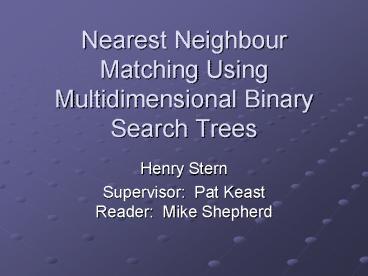Nearest Neighbour Matching Using Multidimensional Binary Search Trees - PowerPoint PPT Presentation
1 / 29
Title:
Nearest Neighbour Matching Using Multidimensional Binary Search Trees
Description:
Given a set of data points and target points in a metric space, find the ... Median of the most deviant dimension. Splitting Strategy vs. Query Cost. Query Cost ... – PowerPoint PPT presentation
Number of Views:133
Avg rating:3.0/5.0
Title: Nearest Neighbour Matching Using Multidimensional Binary Search Trees
1
Nearest Neighbour Matching Using Multidimensional
Binary Search Trees
- Henry Stern
- Supervisor Pat KeastReader Mike Shepherd
2
Nearest Neighbour Matching
- A fundamental computational geometry problem.
- Given a set of data points and target points in a
metric space, find the nearest data point to each
target point. - Cost increases with both the number of points and
the dimensionality of the space.
3
(No Transcript)
4
Process of Nearest Neighbour Matching
- A k-dimensional Euclidean ball with radius r,
centered around the target point contains all
neighbours where distance(targetlt-gtpoint) lt r. - During a nearest neighbour match, the radius of
this ball is the distance from the target point
to the best known match.
5
(No Transcript)
6
Simple Nearest Neighbour Matching Algorithm
- Every point is examined in turn.
- If the point being examined is closer to the
target than all of the previously known matches,
it is saved as the candidate for nearest
neighbour.
7
(No Transcript)
8
(No Transcript)
9
(No Transcript)
10
Simple but Expensive
- Simple nearest neighbour matching algorithm runs
in O(nk) time with space complexity O(nk). - Cheapest solution for a single query.
- For multiple queries, it does not take advantage
of any previous queries.
11
What Other Options Are There?
- Quad Trees
- Multidimensional Binary Search Trees
12
Quad Trees
- Sacrifices space complexity for time complexity.
- O(n) time complexity, expected linear.
- O(n 2k) space complexity.
13
(No Transcript)
14
(No Transcript)
15
(No Transcript)
16
(No Transcript)
17
Multidimensional Binary Search Tree
- kd-trees.
- Sacrifices time complexity for space complexity.
- O(n) time complexity, expected linear.
- O(n) space complexity.
18
(No Transcript)
19
(No Transcript)
20
(No Transcript)
21
Query Optimization for kd-trees
- Region Compression
- Splitting Strategies
22
Region Compression
- Tight bounds for each node are calculated.
- O(n) method while tree is being constructed.
- Significantly reduces query costs.
23
(No Transcript)
24
(No Transcript)
25
(No Transcript)
26
Splitting Strategies
- The choice of splitting dimension can have a
significant impact on query performance. - Success of splitting strategy is highly
data-dependent. - Three strategies examined
- Median of the next dimension (Simple).
- Median of the widest dimension.
- Median of the most deviant dimension.
27
Splitting Strategy vs. Query Cost
28
Query Cost
- Proportional to dimensionality and number of
points. - Critical point when k approaches log n.
- After the critical point, query cost slowly
approaches n.
29
Conclusion
- Nearest neighbour matching in sub-linear time is
a difficult problem. - Time complexity vs. space complexity.
- Difficult to minimize trade-off.
- The kd-tree is ineffective for high-dimensional
nearest neighbour matching.































